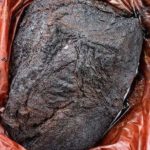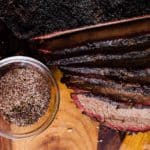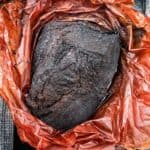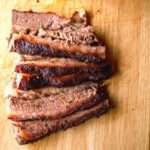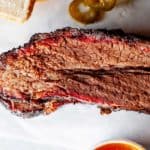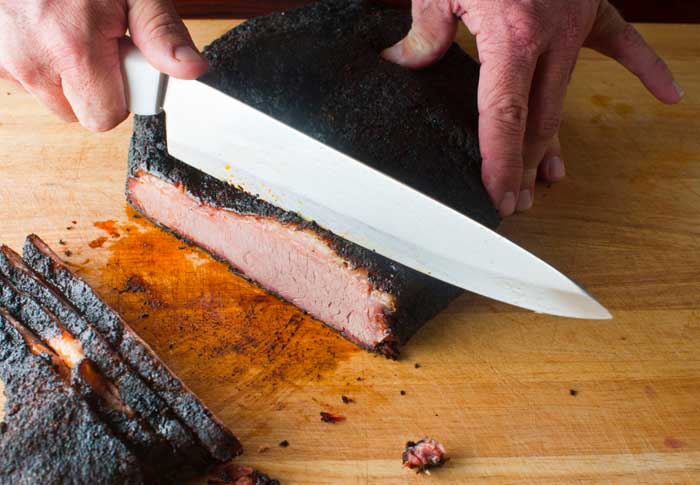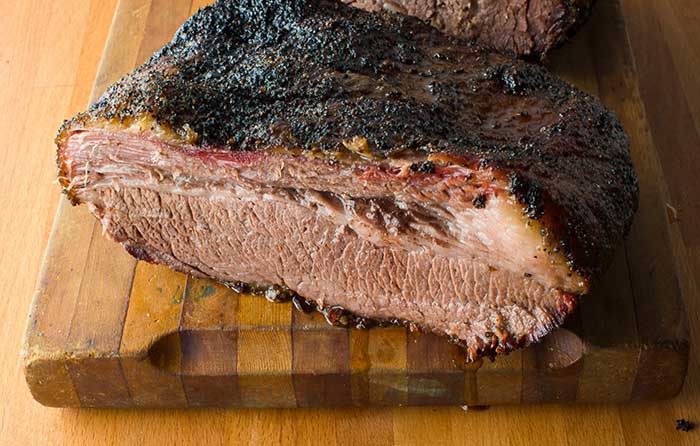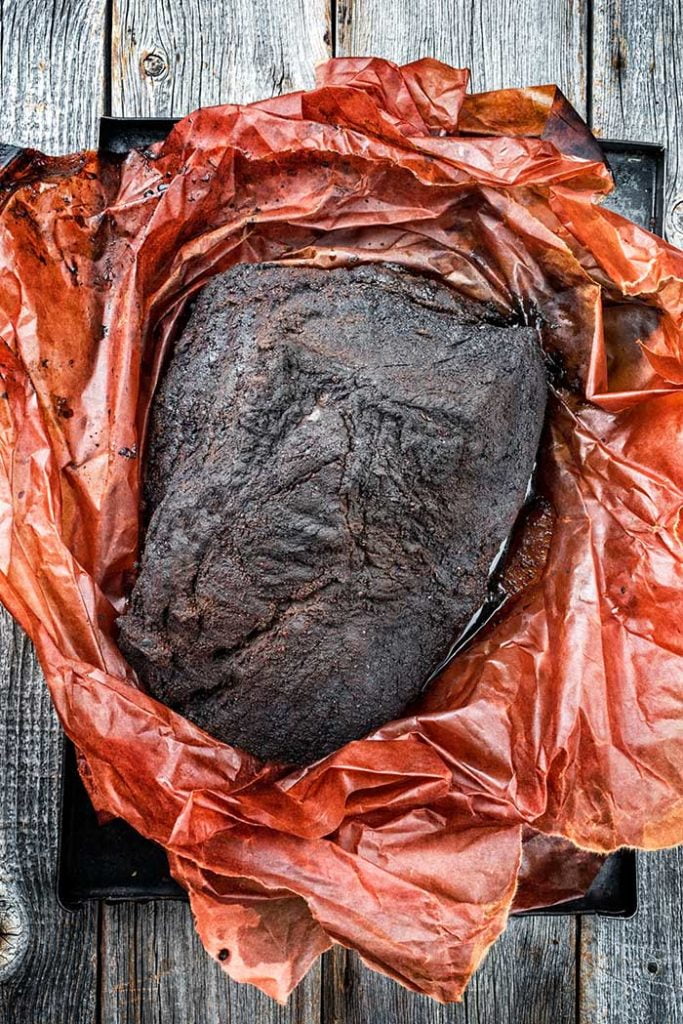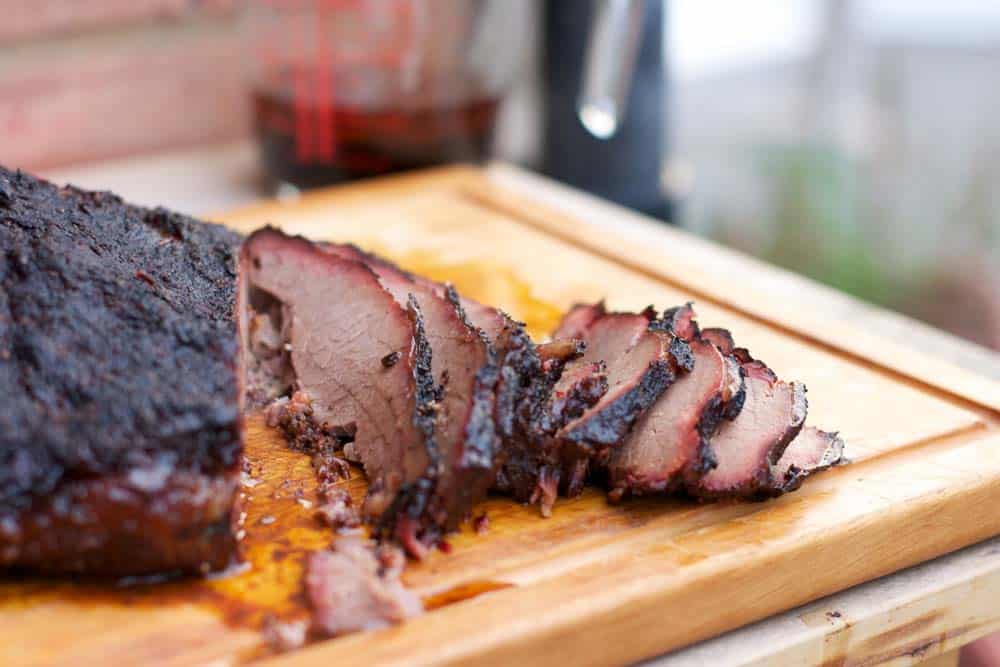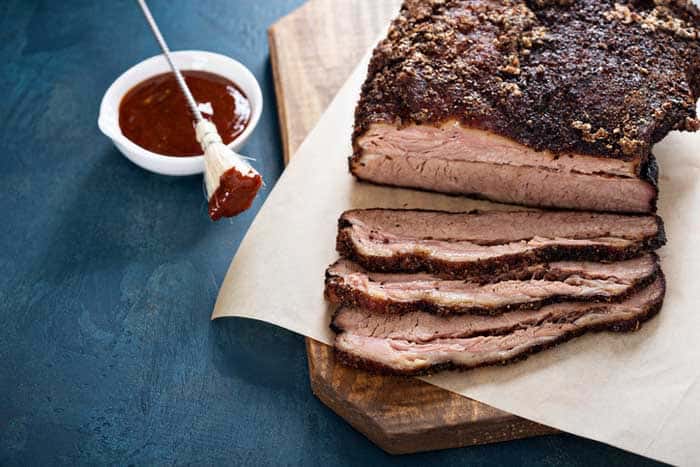Brisket is tender and rich in flavor when fresh off the BBQ smoker, but leftovers can often be dry and bland. Here are six easy methods to reheating beef brisket that keep it tender and delicious.
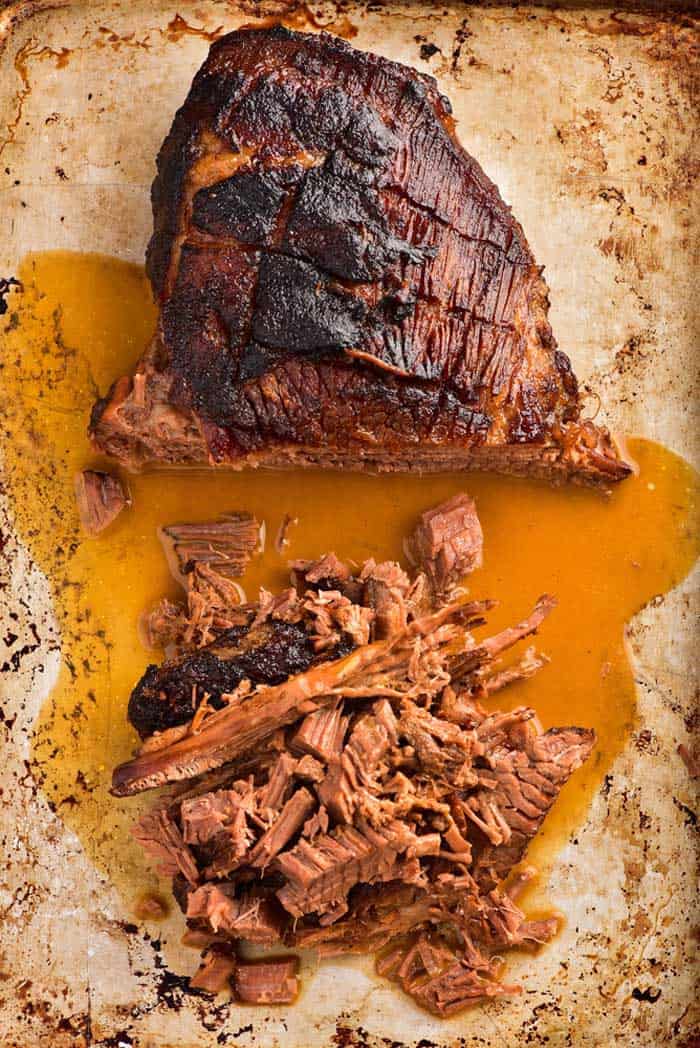
I don’t think there’s a BBQ meat out there that’s more iconic than smoked brisket. It’s not always the easiest food to cook, but if you get it right then it’s probably the most delicious barbecued meat you can have.
Brisket by its very nature is a large cut of meat, which means that your party can’t always finish it one sitting. Even though it can be easily refrigerated to be enjoyed later, it can be difficult to reheat it without losing any of the quality that made it so delicious the first time round.
If it dries out it can be bland, tough, and just downright unpleasant.
The good news though is that it’s easy to do it so that it stays juicy, tender, and delicious. Perfect for making some of your favorite leftover brisket recipes.
This is how to reheat brisket without letting it dry out.
How to store brisket in the refrigerator
The first step actually starts the moment you finish cooking it the first time round. Once you have decided what you are keeping and you have allowed the brisket to cool, drain the meat for any residual juices that are circling around the meat. Do this into a fat separator so that you can easily separate the fat from the juices.
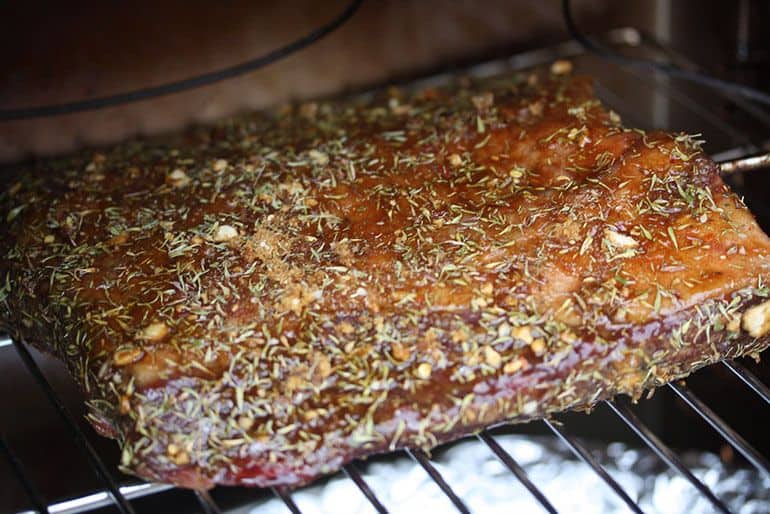
Transfer the brisket to a food pan (this is the kind of thing I mean) and pour the juices in the pan with it and over the meat. Vacuum pack the brisket with the pan into a food saver bag (like this).
If it’s too big to fit in the pan, then you might need to cut the brisket into slices.
Transfer the sealed brisket to your refrigerator. You can keep it there for a maximum of 3 days.
If you would prefer to freeze it then you can, but be prepared to allow it to thaw for a couple of days in your refrigerator after removing it from the freezer.
Side note: I always try to steer clear of smoking frozen meat as it never retains its flavors or moisture as well as I’d like.
How to reheat brisket in a smoker
Remove the brisket and pan from the sealed bag. Use aluminum foil to cover the brisket and then transfer to a preheated smoker or grill at 225°F/110°C.
Got an electric smoker? Learn how to smoke brisket in an electric smoker with our guide.
The foil here is important because it helps the meat reheat while also retaining a lot of its moisture.
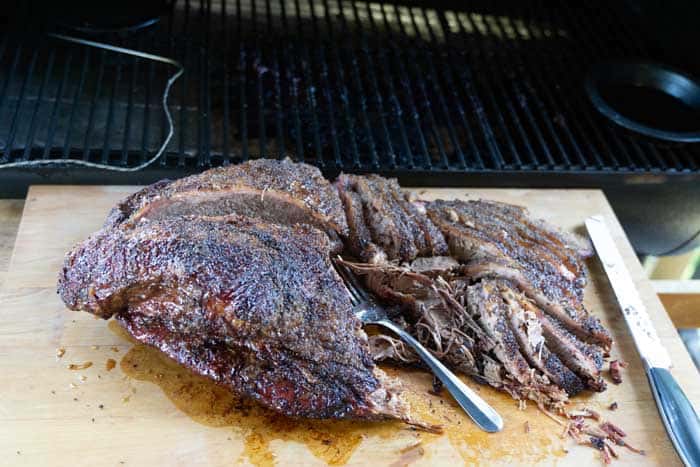
Brisket is best served at 140°F/60°C, so this is our target internal temperature when we reheat it. Use a good wood for smoking brisket, and make sure to include a water pan too.
This should take about 90 minutes per pound of meat. Once it hits this temperature, remove from the smoker, slice up, and serve.
How to reheat brisket in an oven
The best way to reheat brisket without it drying out actually isn’t in a smoker or grill, but instead to use an oven. The shorter cooking time that the oven provides means that there is less chance of your brisket being exposed to high temperatures, and therefore less risk of it drying out.
The oven is the best way of ensuring that the brisket tastes like it’s fresh off the smoker.
The truth is that at this stage we will have already smoked our brisket, so all the hard work of infusing it with flavors and smoke is already done. We simply just need to reheat it.
Preheat your oven to 325°F/160°C.
While your oven preheats, remove the brisket from the refrigerator and let it readjust to room temperature.
Transfer the brisket from the food pan to a deep baking tray. Use the juices to pour over the brisket and fill the deep dish of the pan.
Cover the brisket and tray in aluminum foil. Transfer to preheated oven and cook for 30-45 minutes. Time will vary depending on the size of your brisket, so be sure to check it and use a meat thermometer to monitor the internal temperature of your meat. Once it reaches 140°F/60°C then it’s ready to serve.
How to reheat brisket in a microwave
Using a microwave to reheat meat is far from ideal, and would probably not be anyone’s first choice if quality if the priority. But sometimes time and resources can mean that it’s the only choice you have. No problem though, as we can easily reheat brisket in the microwave.
Transfer the brisket to a microwave-friendly container or tupperware, with the lid loosened to allow slow release of steam as it cooks.
Reduce the heat setting of your microwave to 20 percent (one above ‘defrost’). This will help prevent the brisket from drying out or overcooking.
Turn the microwave on for 30 second bursts. Use your meat thermometer between each heat interval to measure the internal temperature of your meat. We want to achieve a temperature of close to 140°F/60°C. This can take anywhere between 2 and 4 minutes, but will depend on the size of your brisket.
How to reheat brisket in a sous vide machine
I’ll admit that very few people are lucky enough to a sous vide machine, but for those who do they are a great way of reheating food without letting it dry out or overcook.
For those of you not familiar with the cooking method, it’s essentially a means of cooking food by heating it in a water bath. It’s been becoming more and more popular, and it’s not hard to see why. It’s a great way of getting food to retain its moisture without the risk of burning or losing its moisture.
It’s not the quickest way of reheating food, but if you have the equipment then it’s definitely worth a try.
To sous vide reheat brisket, start by vacuum sealing it in watertight plastic wrap before then submerging it in water heated to 160°F/70°C.
Leave your brisket to heat until the internal temperature matches the water’s temperature at 160°F/70°C.
Again, the length of time that this takes will vary depending on how large your cut of brisket is, but as a general rule it should tame somewhere between 4 to 6 hours. You will need to use a meat thermometer to get an accurate reading on this. Just be sure to insert the probe prior to vacuum packing the meat.
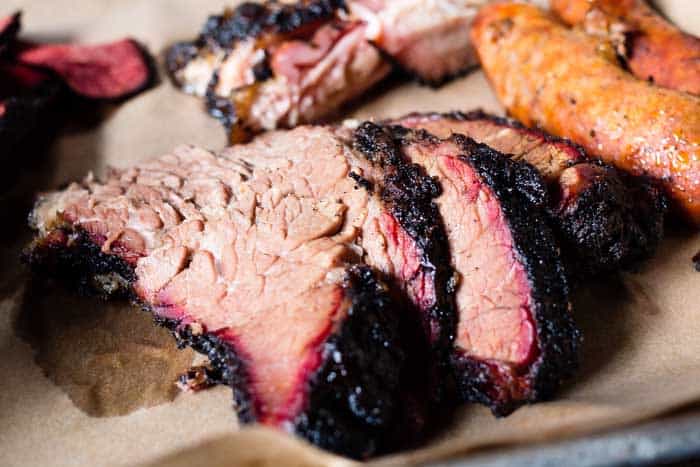
How to reheat brisket in a slow cooker or crockpot
I love crock pot cooking. It’s similar to an oven in that it ensures even heat distribution for keeping meat warm, which is crucial for reheating food, but it also does so at relatively low temperatures which helps the juices and marinades with your food permeate the meat more thoroughly. Which is great in this instance as we still have our recycled juices!
Our only real limitation here is that most crock pots or slow cookers aren’t large enough to accommodate standard sized briskets, so you might need to slice up your meat before putting it in your cooker. This isn’t necessarily a bad thing though, as it will help reduce the amount of time needed to reheat your meat.
What I also really like about crock pot cooking is that you can control the heat and length of time that you reheat the brisket for. This can be much more challenging with putting it back on the grill or smoker, and is even the case with microwave cooking to an extent. They also have an airtight lids, which can help lock in moisture, which will prevent your brisket from drying out.
To reheat it in your crockpot, place the brisket in the ceramic container. Slice it up if you need to. Pour the leftover juice over the meat. Set between 185 and 200°F (85 to 95°C), and leave for 4 hours or until internal temperature reaches 165°F/75°C.
How to reheat brisket in a convection oven
While I have mentioned oven cooking, I wanted to give a special mention to convection (or fan) ovens because you will need to approach reheating slightly differently with these.
Convection ovens are much more efficient than conventional ovens in that they have an inbuilt fan that blows hot air around the oven’s interior, spreading the heat much more evenly and helping to reduce the risk of hot spots.
Not only does this mean that you don’t need to adjust or flip your food at any point, but it also means that it in effect raises the overall temperature inside the oven.
If you are using a convection oven, or using the convection setting on your oven, I recommend reducing the temperature by 25°F, and also the cooking time by about 20 percent. This should roughly translate to 200°F for 2 hours per pound of meat.
The internal temperature of the brisket is still key though, so ultimately the time needed will be dictated by how long it takes for your brisket to reach 140F-160F.
Just like with our conventional oven method, pour the leftover juices over the brisket and then wrap the brisket in aluminum foil prior to putting it in the oven.
Once it is cooked, remove from the oven and leave to rest for 30 minutes still wrapped in foil.
What’s the best way to reheat brisket slices?
A lot of what I’ve outlined above assumes that you are reheating brisket whole, or in large portions. However in a lot of instances, you might be wanting to reheat slices of brisket.
This will significantly reduce the amount of time you need to reheat your brisket, and so I would recommend using an oven.

The reduced cooking time means that it’s not really worth the effort in setting up your smoker, while using a microwave will just dry it out very quickly.
Keep the same temperature settings and cook for 10-20 minutes, depending on the thickness of the slices. Once again, the sign that it’s done will be when the meat temperature hits 140°F-160°F (60-70°C).
Should I slice brisket before reheating?
If you have the luxury of choice here then this is completely up to you, and will largely depend on how much time you have or are willing to put into reheating it.
If you’re limited for time then slicing it up prior to reheating it is a great way to get things moving along quickly. Just be sure that you use a knife that’s up to the job.
However, personally I would go for leaving the brisket whole. While this will mean it takes longer, it gives you far greater opportunity to re-infuse the brisket with the flavors of the juices, improving the quality of the meat and its flavors.

